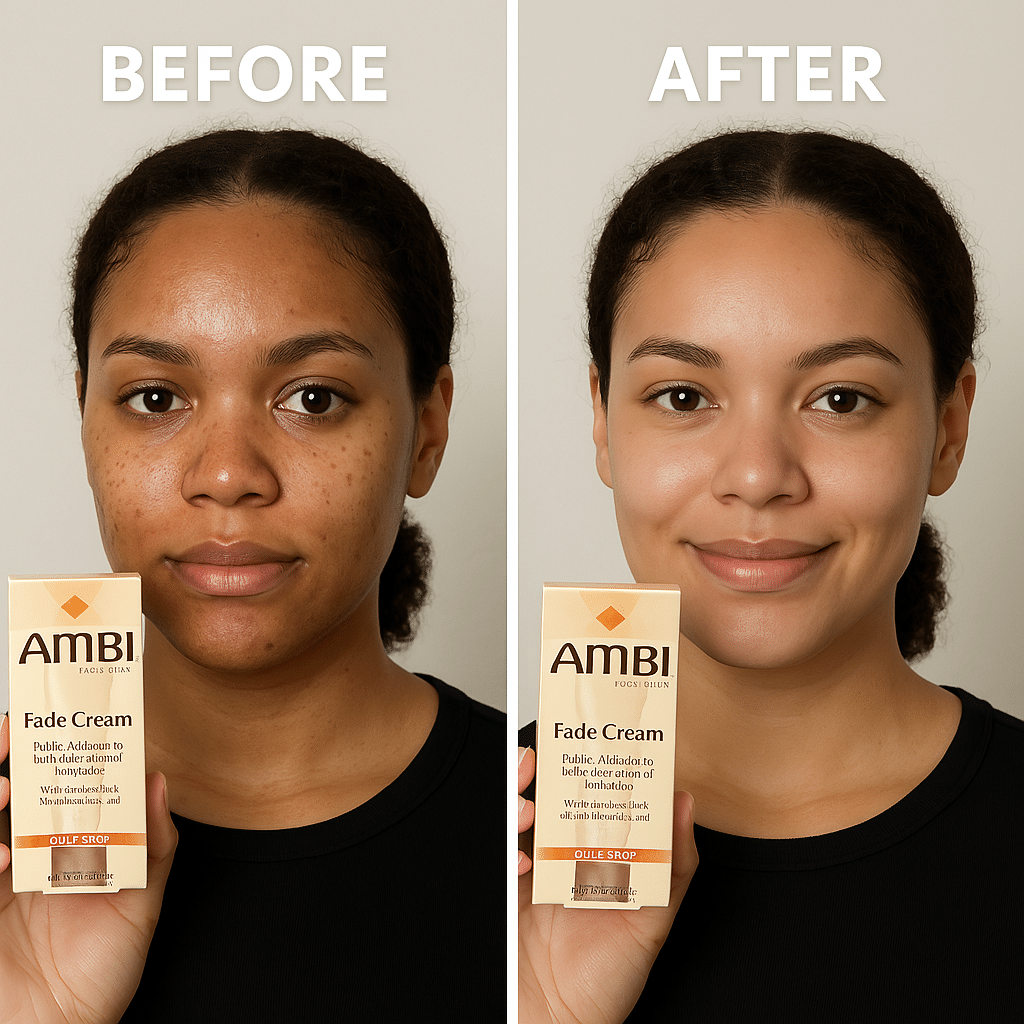Struggling with persistent dark spots along your oily T-zone? You’re not alone. Oil-induced hyperpigmentation occurs when excess sebum triggers inflammation and uneven melanin production, leaving behind stubborn marks. Ambi Fade Cream’s 2% hydroquinone formula is engineered to address precisely this challenge—lightening spots without adding extra shine. In this deep dive, we’ll unpack the science, application tactics, safety measures, and real-world results to help you harness Ambi’s power effectively.
Understanding Oil-Induced Dark Spots
Excess oil production doesn’t just cause breakouts—it can fuel post-inflammatory hyperpigmentation (PIH). Here’s how:
- Sebum & Inflammation
Overactive sebaceous glands lead to clogged pores. When a pore becomes inflamed, it signals melanocytes (pigment-producing cells) to overproduce melanin. - Melanin Clumping
Instead of dispersing evenly, melanin clusters appear as dark spots, most common on oily areas like the forehead, nose, and chin. - Persistence of Lesions
Unlike sunspots, PIH can linger for months after a blemish has healed, especially if the skin barrier is compromised or constantly irritated.
Identifying your skin type and understanding this process is the first step toward effective treatment.
What Is 2% Hydroquinone and How Does It Work?
Hydroquinone is heralded as the gold standard for fading hyperpigmentation. At a 2% concentration, it offers a balance of efficacy and tolerability, especially for over-the-counter use.
- Enzyme Inhibition
Hydroquinone halts the tyrosinase enzyme, which converts tyrosine into melanin precursor DOPA within melanocytes. - Melanocyte Suppression
By interrupting this pathway, hydroquinone reduces melanin synthesis and the transfer of pigment to surrounding skin cells. - Concentration Matters
While prescription strengths can go up to 4%, a 2% formula like Ambi’s provides noticeable fading within 4–8 weeks for many users, with lower irritation risk.
This targeted action makes hydroquinone especially effective on oil-induced spots, where inflammation and excess melanin go hand in hand.
Why Ambi Fade Cream’s Formula Excels on Oily Skin
Not all fade creams suit an oily complexion. Ambi Fade Cream stands out because of its lightweight, non-comedogenic base:
| Feature | Benefit for Oily Skin |
|---|---|
| 2% Hydroquinone | Powerful spot-fading without heaviness |
| Octinoxate (2%) | UV protection that prevents spot re-darkening |
| Vitamin E (Tocopheryl Acetate) | Antioxidant support to calm irritation |
| Lactic Acid | Gentle exfoliation for improved absorption |
This synergy ensures that the active ingredient penetrates effectively without leaving a greasy residue or clogging pores.
Step-by-Step Guide: Applying Ambi Fade Cream for Maximum Results
A consistent routine amplifies hydroquinone’s benefits. Follow these steps twice daily:
- Cleanse Gently
Use a mild, oil-free cleanser to remove excess sebum and prep the skin barrier. - Tone (Optional)
If your skin tolerates it, apply an alcohol-free toner with soothing botanicals to balance pH. - Spot Treat
Dab a pea-sized amount of Ambi Fade Cream directly onto dark spots. For wider areas of uneven tone, apply a thin layer over the entire oily zone. - Moisturize
Seal in hydration with a gel-cream moisturizer that won’t add extra shine. - Sunscreen
In the morning, never skip a broad-spectrum SPF 30+—UV exposure can reverse your progress and increase PIH risk.
Consistency is key. Results typically emerge around week 4, with more dramatic fading by week 8–12.
Safety, Precautions, and Patch Testing
Hydroquinone is safe when used correctly, but you should guard against irritation and the rare risk of exogenous ochronosis (blue-black darkening):
- Patch Test First
Apply a small amount on your inner forearm. Wait 24 hours to rule out sensitivity. - Limit Use Duration
Most dermatologists recommend cycling hydroquinone—use it for up to 3 months, then take a 1‐ to 2-month break. - Avoid Mixing Actives
Don’t layer strong retinoids or chemical exfoliants immediately over hydroquinone to prevent over-exfoliation. - Sun Protection
Diligent sunscreen use is non-negotiable. Hydroquinone makes skin more UV-sensitive, risking rebound pigmentation.
By respecting these guidelines, you’ll harness Ambi Fade Cream’s benefits while minimizing side effects.
Real-Life Results: A Week-by-Week Look
Week 1–2
You may notice slight dryness or tingling as your skin adjusts. Mild exfoliation helps prep pores for the active ingredient.
Week 3–4
Initial lightening of deeper spots. Tone begins to even out, and overall clarity improves.
Week 5–8
Dark spots fade visibly, and new ones appear less pronounced. Skin texture feels smoother due to lactic acid’s gentle exfoliation.
Week 8+
Consistent use reveals a balanced, brighter complexion. Many users report a 50–70% reduction in spot intensity by week 12.
Remember, individual results vary based on skin tone, severity of pigmentation, and adherence to sun protection.
Frequently Asked Questions
- Can I use Ambi Fade Cream on my entire face?
Yes. It’s safe as an all-over treatment, especially on oily zones, but spot treatment delivers faster fading on individual marks. - Will it make my skin overly dry?
Some dryness can occur. Balance with a lightweight moisturizer and reduce application to once daily if needed. - How soon will I see results?
Many users note improvement around 4 weeks, with full results by 8–12 weeks. - Is hydroquinone safe for darker skin tones?
When used properly and cycled, it’s safe. Rare cases of ochronosis appear only with prolonged, high-strength misuse. - Can I layer vitamin C or retinol?
Use vitamin C in the morning and retinol at night, but avoid stacking them directly with hydroquinone to prevent irritation.
Conclusion
Oil-induced dark spots can be stubborn, but they’re not invincible. Ambi Fade Cream’s 2% hydroquinone formula delivers targeted, science-backed fading while respecting oily skin’s unique needs. Pair consistent application with sun protection, patch testing, and smart cycling to reveal a clearer, more even complexion.
By layering these strategies, you’ll not only fade existing spots but also fortify your skin against future pigmentation woes.
